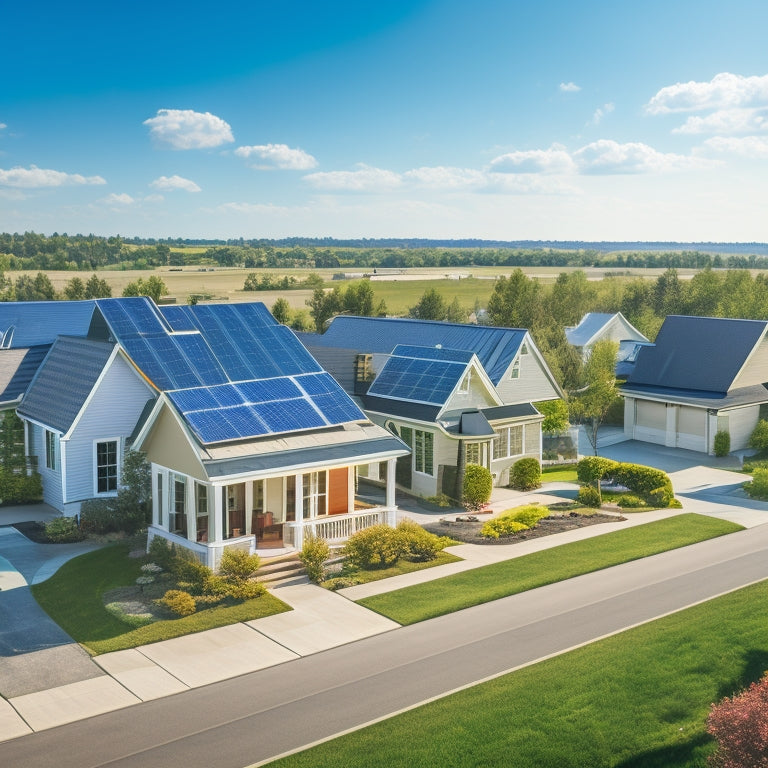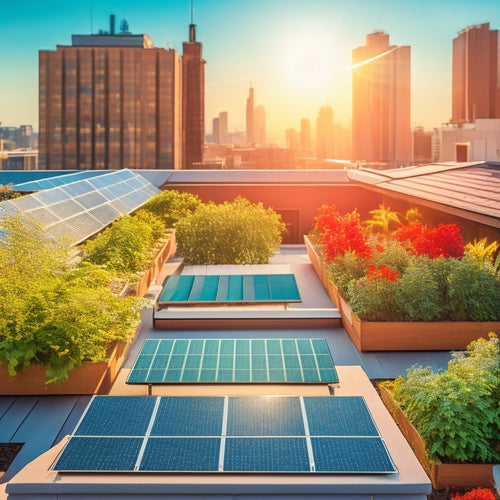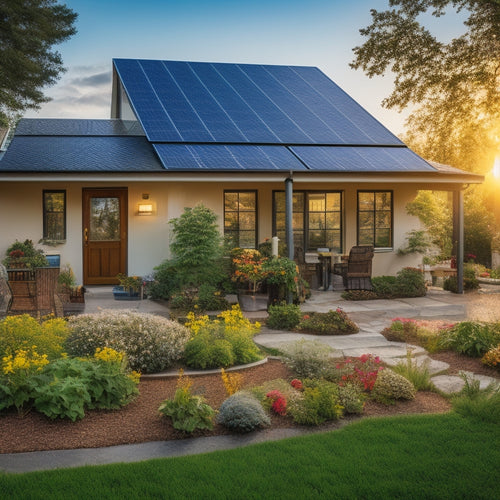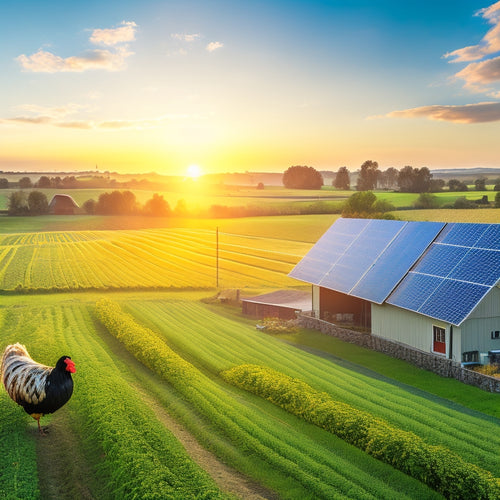
What Are the 7 Most Affordable Solar Panels for Houses
Share
You're looking for a solar panel system that fits your budget without sacrificing performance, and with prices as low as $2.50 per watt, you've got a range of affordable options to choose from. Trina, Jinko, and Hanwha's Q CELLS are some of the top brands offering high-efficiency panels at competitive prices. LONGi, JA Solar, and Risen Energy also provide budget-friendly options with impressive warranties. When evaluating solar panels, consider factors like cost per watt, system size, and installation costs to maximize your ROI. To find the perfect fit for your home and budget, investigate these options further to uncover the best value for your investment.
Key Takeaways
- Top value solar panels are priced as low as $2.50 per watt, making them an affordable option for houses.
- Look for solar panels with high efficiency ratings (above 20%) for maximum energy output per unit area.
- The Solar Investment Tax Credit (ITC) offers up to a 26% tax credit on total solar panel system costs, reducing the overall expense.
- Financing options, government incentives, and DIY installation can significantly reduce the upfront cost of solar panels for houses.
- Affordable solar panel brands like Trina, Jinko, and Hanwha offer high-quality modules with competitive pricing and warranties.
Budget-Friendly Options for Homes
Several budget-friendly options for homeowners looking to switch to solar energy are available in the market. You can take advantage of solar incentives, such as the Solar Investment Tax Credit (ITC), which allows you to claim a tax credit of up to 26% of the total cost of your solar panel system.
Additionally, many states offer rebates and tax credits for solar installations. When it comes to financing options, you have several choices. You can opt for a cash purchase, which provides the most savings in the long run.
Alternatively, you can consider financing through a loan or a power purchase agreement (PPA). Many solar panel manufacturers and installers also offer financing options, making it easier for you to switch to solar energy.
Some companies even offer zero-down financing, allowing you to start saving on your electricity bills immediately. By exploring these budget-friendly options, you can make the shift to solar energy without breaking the bank.
Top Value Solar Panels Today
You're likely looking for solar panels that offer the best value for your money.
Today, top value solar panels come in two main categories: best price options that provide a cost-effective entry point into solar energy, and high-efficiency choices that maximize energy output per unit area.
Best Price Options
When shopping for affordable solar panels for your house, finding the best price options can be a challenging task. You need to evaluate factors such as the cost per watt, system size, and installation costs.
To make the process easier, look for manufacturers that offer competitive pricing without compromising on quality.
You can also take advantage of solar incentives, such as the federal solar investment tax credit (ITC), which can help reduce the upfront cost of your solar panel system.
Additionally, investigate financing options, like loans or power purchase agreements (PPAs), to spread the cost over time.
Some top value solar panels today offer prices as low as $2.50 per watt. These systems are designed to provide ideal energy output while keeping costs in check.
High-Efficiency Choices
With pricing in check, your focus shifts to maximizing energy output while minimizing costs. You're looking for high-efficiency solar panels that can generate more power per hour of sunlight.
Top quality solar panels today incorporate state-of-the-art high-efficiency technologies that make them well worth the investment. Panels with higher efficiencies, typically above 20%, are achieved through advanced solar panel innovations such as bifacial cells, multi-busbar designs, and PERC (passivated emitter and rear cell) technology.
These innovations enable more efficient energy conversion, resulting in higher power output per unit area. This means you can generate more electricity with fewer panels, reducing your overall installation cost.
Some high-efficiency solar panels even boast efficiencies above 22%. These premium panels are ideal for homes with limited roof space or those seeking to maximize their energy production.
While they may come at a higher upfront cost, their increased energy output and reduced installation costs make them a worthwhile long-term investment.
Cheap Solar Panels for Roof
When evaluating cheap solar panels for your roof, you'll need to assess the size of your roof and the capacity you require, as this will impact the number of panels you'll need to purchase.
You'll also want to evaluate the efficiency of different panels and their corresponding cost, as more efficient panels may be more expensive upfront but provide greater long-term savings.
Additionally, you'll need to contemplate the installation and mounting options that are compatible with your roof's design and structure.
Roof Size and Capacity
How much energy can your roof realistically produce? The answer depends on the size and capacity of your roof. A typical residential roof in the US can accommodate a solar panel system ranging from 3 to 10 kilowatts (kW).
To determine your roof's capacity, consider its size, orientation, and panel placement. A south-facing roof with minimal shading is ideal, as it can produce the most energy.
Roof orientation affects energy production, with south-facing roofs producing the most energy. East- and west-facing roofs can still produce a significant amount, but north-facing roofs are the least productive.
Panel placement is also essential, as it can impact energy production. Avoid placing panels in shaded areas or near obstructions that can reduce energy output.
To calculate your roof's capacity, measure its size in square feet and multiply it by the amount of peak sun hours your area receives per day. For example, a 2,000-square-foot roof in an area with 5 peak sun hours can support a 10 kW system.
Panel Efficiency and Cost
Your solar panel system's efficiency and cost are essential factors to take into account when selecting the right panels for your roof.
Efficiency determines how much energy your panels can generate from sunlight, while cost affects your upfront investment and long-term savings.
When evaluating panel efficiency and cost, consider the following factors:
-
Panel efficiency rating: A higher rating means more energy produced per unit area.
-
Panel lifespan: Look for panels with a long lifespan (25+ years) to maximize energy production over time.
-
Warranty coverage: A thorough warranty can provide peace of mind and protect your investment.
- Cost per watt: Calculate the cost per watt of energy produced to compare panels from different manufacturers.
Installation and Mounting Options
Since you've selected the ideal solar panels for your house, it's vital to evaluate the installation and mounting options to guarantee a secure and efficient setup.
You'll need to take into account the installation challenges of your roof, such as its size, shape, and material. For instance, tile or metal roofs may require specialized mounting systems to guarantee a secure fit.
When it comes to mounting systems, you have several options. Rail-based systems are the most common, providing a sturdy foundation for your solar panels. However, they can be more expensive and may require additional labor for installation.
Clamp-based systems, on the other hand, are more versatile and can be used on a variety of roof types. Ballasted systems are another option, which use weights to secure the panels instead of penetrating the roof.
It's important to consult with a professional installer to determine the best installation and mounting options for your specific roof and solar panel setup.
They can assess your roof's unique challenges and recommend the most suitable solution to guarantee a safe and efficient installation.
Affordable Renewable Energy Systems
Employing renewable energy sources becomes increasingly essential as the world progresses towards a more sustainable future.
As you consider shifting to renewable energy, you'll want to investigate affordable options that provide significant energy savings and incentives.
When it comes to affordable renewable energy systems, you have several choices to select from:
-
Solar Power Systems: These systems convert sunlight into electricity, providing a clean and renewable source of energy.
-
Wind Turbine Systems: Wind turbines generate electricity by capturing wind energy, making them a viable option for homes with suitable wind conditions.
-
Geothermal Systems: These systems draw on heat from the earth to provide heating, cooling, and hot water, offering an efficient and eco-friendly solution.
- Biomass Systems: Biomass systems burn organic matter (e.g., wood chips, agricultural waste) to produce heat and electricity, providing a renewable alternative to fossil fuels.
Solar Panel Cost Breakdown
Determine your solar panel cost by breaking it down into its key components.
You'll need to evaluate the cost of the solar panels themselves, the inverters, mounting hardware, and installation labor. Add to that the cost of permits, inspections, and connection to the grid. The total cost will also depend on the size of your system, measured in watts (W).
On average, the cost of solar panels ranges from $2.50 to $3.50 per watt. Inverters add another $0.10 to $0.30 per watt. Mounting hardware and installation labor costs vary depending on the complexity of the installation. You can expect to pay around $1.00 to $2.00 per watt for these services.
Fortunately, there are solar incentives and financing options available to help offset the upfront cost.
The Solar Investment Tax Credit (ITC) allows you to claim a tax credit of 26% of the total cost. Additionally, many states and utilities offer rebates and other incentives. You can also investigate financing options like loans or power purchase agreements (PPAs) to make solar energy more accessible.
Low-Cost Solar Installation Options
Now that you have a better understanding of the solar panel cost breakdown, it's time to examine ways to make your solar installation more affordable.
You're likely enthusiastic to utilize the power of solar energy without breaking the bank. Fortunately, there are several low-cost solar installation options to investigate.
To reduce your upfront costs, consider the following:
-
Financing options: Many solar panel manufacturers and installers offer financing plans or loans to help spread the cost over time.
-
Government incentives: Take advantage of federal and state tax credits, rebates, and grants that can considerably reduce your solar installation costs.
-
DIY installation: If you're comfortable with DIY projects, you can save on labor costs by installing the solar panels yourself.
- Used or refurbished solar panels: You can purchase used or refurbished solar panels at a lower cost, but be sure to inspect their condition and warranty before making a purchase.
Best Budget Solar Panel Brands
With a clear understanding of low-cost solar installation options, you can further reduce your expenses by selecting budget-friendly solar panel brands.
Affordable brands like Trina, Jinko, and Hanwha offer high-quality solar panels at competitive prices. When making budget comparisons, contemplate factors like efficiency, durability, and warranty periods.
For instance, Trina's TALLMAX M10 module boasts an impressive 21.9% efficiency rate, while Jinko's Cheetah module offers a 12-year warranty. Hanwha's Q CELLS module, on the other hand, features a 25-year warranty and 20.6% efficiency rate.
Other affordable brands to contemplate include LONGi, JA Solar, and Risen Energy. These brands offer a range of options to suit your specific needs and budget.
Frequently Asked Questions
Can I Install Solar Panels on a Rented Property?
You can investigate installation options for solar panels on a rented property, but you'll need to review your renting agreements to confirm you have permission and understand any potential restrictions or requirements from your landlord.
Do Solar Panels Increase My Home's Value?
You'll likely enhance your home's value by installing solar panels, thanks to solar incentives and long-term energy savings, which can recoup up to 50% of the total cost, making your property more attractive to potential buyers.
Will Solar Panels Work During a Power Outage?
When the lights go out, you're left in the dark, but solar panels can be a guiding light of hope. During a power outage, your solar panel system won't provide electricity unless you have a battery backup or a grid-tie inverter with backup capabilities, ensuring you stay powered up.
Can I Use Solar Panels for My RV or Boat?
You can definitely use solar panels for your RV or boat, and a proper solar panel installation will guarantee you're utilizing renewable energy on the go; consider specialized RV solar systems designed for mobile power generation.
Are Solar Panels Resistant to Hail and Extreme Weather?
You're building a fortress of renewable energy, and hail is the arch-nemesis; rest assured, quality solar panels are designed to withstand hail damage, boasting weather durability that lets them emerge unscathed from even the most brutal storms.
Conclusion
Considering solar panels for your home but worried about the cost? Don't be. With prices dropping, affordable options abound. Take, for example, a California homeowner who installed a 5-kW system for just $15,000, saving $800 annually on their electricity bill. By choosing the right panel and installer, you can reap similar benefits without breaking the bank. Research and compare prices to find the best fit for your budget and energy needs.
Related Posts
-

Solar System Installation Rebates and Tax Credits
Solar system installations offer beneficial rebates and tax credits that greatly cut your initial costs. You can bene...
-

How to Achieve Energy Independence at Home
To achieve energy independence at home, start by investing in renewable energy sources like solar panels, wind turbin...
-

Solar Power Advantages for Rural Communities
Solar power presents numerous advantages for rural communities. You can greatly reduce energy costs, potentially by u...


